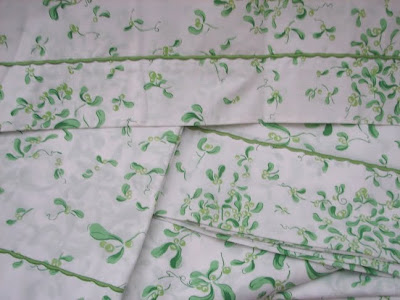 French photo postcard, "MARCHAND DE GUI DE BRETAGNE", Mistletoe Vendor from Brittany, 1908; note the distinctive regional costume with double-breasted, brass buttoned coat, voluminous breeches, and wooden shoes
French photo postcard, "MARCHAND DE GUI DE BRETAGNE", Mistletoe Vendor from Brittany, 1908; note the distinctive regional costume with double-breasted, brass buttoned coat, voluminous breeches, and wooden shoesFor years I've collected vintage Christmas items; cards, vinyl records, decorations, table linens, magazines, etcetera. I noticed that in pieces dating from the late 19th century and early 20th century, the mistletoe (Viscum album) motif was very much in fashion, in fact much more than the poinsettia or Christmas tree that we see on Christmas cards today. The mistletoe motif was also very popular to decorate items in general day to day use, not just for Christmas. The majority of these mistletoe items are in the Art Nouveau/ Jugenstil style that coincided in England and British Empire with the Edwardian epoch. Nowadays, few people know what mistletoe is, and the plant seems all but forgotten.
Mistletoe is a mysterious plant. It is a parasitic evergreen plant that grows on the limbs of trees and has attractive pearl-like, luminous berries. It was sacred to the Druids, and had to be cut with great ceremony wearing white robes, at a particular time, and with a special golden sickle. Because it was never to touch the ground, the harvest area was covered with a cloth while mistletoe was cut. The Catholic Church banned the use of mistletoe because of Pagan associations. It continued to be used secretly because it was believed to be so powerful. It was believed to protect from demons, witches, and spirits, and a number of illnesses including fevers, tremors, and fits. Hanging it in the home was believed to bring happiness and peace, and it was often left up throughout the year until the following Christmas.
In the 19th century, the popular custom of kissing under the mistletoe became established. Men were entitled to steal a kiss each time a woman was under the mistletoe. For each kiss, a berry had to be removed from the spray. The ritual ceased when all berries were gone. This charming, and somewhat suggestive custom captured popular imagination, and references to it still persist in old Christmas illustrations, songs, stories, and poems.
Next time you see mistletoe, freshly cut, growing on the branch of an oak, or in the decorative arts, consider the historic, botanic, cultural, and festive aspects of this exquisite, unusual plant.
Merry Christmas to all.
 English matte glaze ironstone pitcher with raised mistletoe motif, circa 1895
English matte glaze ironstone pitcher with raised mistletoe motif, circa 1895 detail of above pitcher
detail of above pitcher Art Nouveau/ Edwardian silver bar style pin with mistletoe motif, circa 1905
Art Nouveau/ Edwardian silver bar style pin with mistletoe motif, circa 1905 Edwardian bone china plate in a Christmas pattern, by Adderley of England, circa 1910; note the raised enamel berries of the holly and mistletoe
Edwardian bone china plate in a Christmas pattern, by Adderley of England, circa 1910; note the raised enamel berries of the holly and mistletoe vintage Swiss linen handkerchief with mistletoe and holly motifs, circa 1965; this item was given as a Christmas gift/ promtional item by a Toronto hotel
vintage Swiss linen handkerchief with mistletoe and holly motifs, circa 1965; this item was given as a Christmas gift/ promtional item by a Toronto hotel






I love the mistletoe motif, particularly that last, stunning piece of jewelry. I was listening to PBS radio, and they mentioned just yesterday that enemies in battle would halt for a day if mistletoe were in the vicinity.
ReplyDeleteAbsolutely fascinating! You have such a great collection! Not sure I would want to be kissed by our Mistletoe vendor though! We dont have the traditional Mistletoe in Australia, and always wondered what it was like. We have another variant that we call mistletoe which is also a parasitic plant of which there are 85 species, mainly in the Loranthaceae family.
ReplyDeleteMerry Christmas and thankyou for all your support of Savoir Faire!
David
How funny that the mistletoe motif, which was so fashionable in our grandparents' time, is not widely recognised now. Even more strange if the mistletoe items used to be in the Art Nouveau style, a style much loved in today's auction houses.
ReplyDeleteIn Australia, we don't have snow, mistetoe, holly, open fires or hot roasted meats. Yet most men would know to grab a quick kiss if they saw a mistletoe hanging down :)